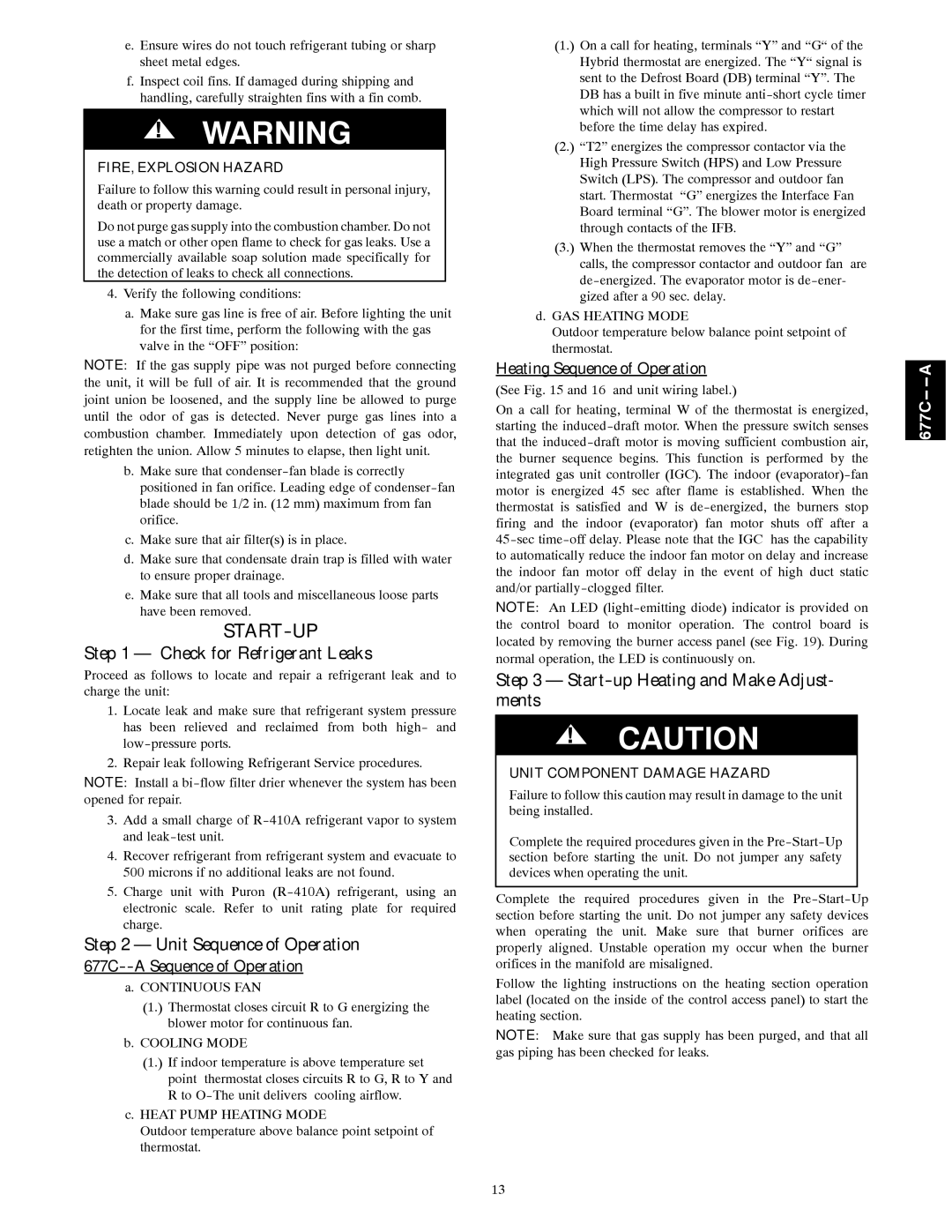
e.Ensure wires do not touch refrigerant tubing or sharp sheet metal edges.
f.Inspect coil fins. If damaged during shipping and handling, carefully straighten fins with a fin comb.
!WARNING
FIRE, EXPLOSION HAZARD
Failure to follow this warning could result in personal injury, death or property damage.
Do not purge gas supply into the combustion chamber. Do not use a match or other open flame to check for gas leaks. Use a commercially available soap solution made specifically for the detection of leaks to check all connections.
4. Verify the following conditions:
a.Make sure gas line is free of air. Before lighting the unit for the first time, perform the following with the gas valve in the “OFF” position:
NOTE: If the gas supply pipe was not purged before connecting the unit, it will be full of air. It is recommended that the ground joint union be loosened, and the supply line be allowed to purge until the odor of gas is detected. Never purge gas lines into a combustion chamber. Immediately upon detection of gas odor, retighten the union. Allow 5 minutes to elapse, then light unit.
b.Make sure that
c.Make sure that air filter(s) is in place.
d.Make sure that condensate drain trap is filled with water to ensure proper drainage.
e.Make sure that all tools and miscellaneous loose parts have been removed.
START-UP
Step 1 — Check for Refrigerant Leaks
Proceed as follows to locate and repair a refrigerant leak and to charge the unit:
1.Locate leak and make sure that refrigerant system pressure has been relieved and reclaimed from both high- and
2.Repair leak following Refrigerant Service procedures.
NOTE: Install a
3.Add a small charge of
4.Recover refrigerant from refrigerant system and evacuate to 500 microns if no additional leaks are not found.
5.Charge unit with Puron
Step 2 — Unit Sequence of Operation
677C--A Sequence of Operation
a. CONTINUOUS FAN
(1.) Thermostat closes circuit R to G energizing the blower motor for continuous fan.
b. COOLING MODE
(1.) If indoor temperature is above temperature set point thermostat closes circuits R to G, R to Y and R to
c.HEAT PUMP HEATING MODE
Outdoor temperature above balance point setpoint of thermostat.
(1.) On a call for heating, terminals “Y” and “G“ of the Hybrid thermostat are energized. The “Y“ signal is sent to the Defrost Board (DB) terminal “Y”. The DB has a built in five minute
(2.) “T2” energizes the compressor contactor via the High Pressure Switch (HPS) and Low Pressure Switch (LPS). The compressor and outdoor fan start. Thermostat “G” energizes the Interface Fan Board terminal “G”. The blower motor is energized through contacts of the IFB.
(3.) When the thermostat removes the “Y” and “G” calls, the compressor contactor and outdoor fan are
d.GAS HEATING MODE
Outdoor temperature below balance point setpoint of thermostat.
Heating Sequence of Operation
(See Fig. 15 and 16 and unit wiring label.)
On a call for heating, terminal W of the thermostat is energized, starting the
NOTE: An LED
Step 3 — Start-up Heating and Make Adjust- ments
!CAUTION
UNIT COMPONENT DAMAGE HAZARD
Failure to follow this caution may result in damage to the unit being installed.
Complete the required procedures given in the
Complete the required procedures given in the
Follow the lighting instructions on the heating section operation label (located on the inside of the control access panel) to start the heating section.
NOTE: Make sure that gas supply has been purged, and that all gas piping has been checked for leaks.
677C-- -- A
13
